Fractals: Mapping Forms in Nature
The Thousand Words Project (Organization), Catherine Cargile, Lewiston Middle School, 7th Grade Interdisciplinary
“For me the most important instrument of thought is the eye. It sees similarities before a formula has been created to identify them.” -Benoit Mandelbrot
Intro:
Overview:
Students will discover the ways that fractal geometry interrelates artistic, scientific, and mathematical approaches to investigating natural forms, patterns and systems.
Learning Goals:
Students will develop an introductory concept of what a fractal is and how it relates to structures and forms in the natural world. (MLR Science A3, A4, E1)
Students will become familiar with the mathematician Benoit Mandelbrot and his work developing fractal geometry. (MLR Science, C1, C2, C3)
Students will be able to measure angles found in natural forms using a protractor. (MLR Science B1, Mathematics A3, C1)
Students will be able to identify the use of different fractal forms in various artworks. (MLR Visual Arts D1, E1)
Students will develop skills using concepts from fractal geometry, including iteration, self-similarity and scaling, to create natural forms using ink and a variety of brush techniques. (MLR Visual Arts B3, C1)
Questions:
What is a fractal? Where do we see fractal forms in nature?
What does ‘fractal dimension’ mean? How can one measure a jagged, irregular shape?
Who is Benoit Mandelbrot? What is his role in the development of fractal geometry?
What role did computer graphics play in the development of fractal geometry? What is the ‘Mandelbrot set’?
How has the artistic process contributed to our understanding of fractals in nature?
Vocabulary:
Fractal Iteration Scaling Self-Similarity Irregular Pattern
Transformation Substitution Repetition Branching Dimension
Symmetry System Equation Texture Angle Degree
Images:
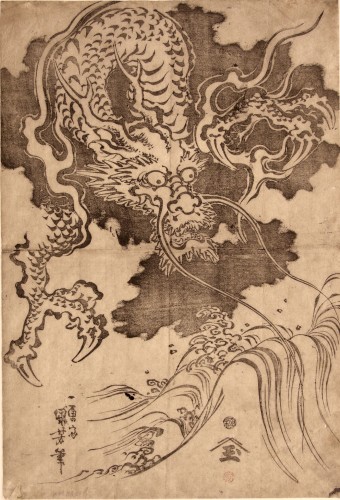
Utagawa Kuniyoshi (1797-1861, Japanese)
Dragon Over Waves,
ca. 1830, Woodcut, 15 3/4 x 10 1/4, ,Gift of Weston and Mary Naef, 1994,
1994.24.34a
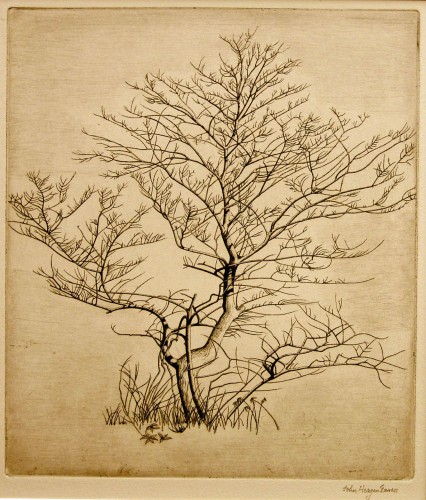
John Haegan, Eames – American
Twiggy
1969, Etching, 1992.1.20
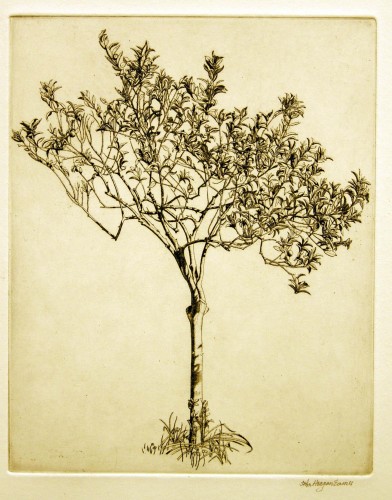
John Haegan Emaes – American
Little Orange Tree
1973, Etching, 1992.1.23
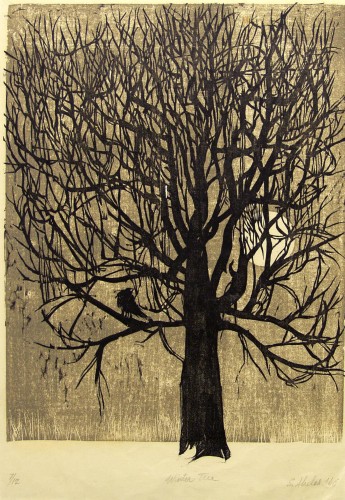
Sigmund, Abeles – American
Winter Tree
1960, Woodcut, two color, 1995.5.
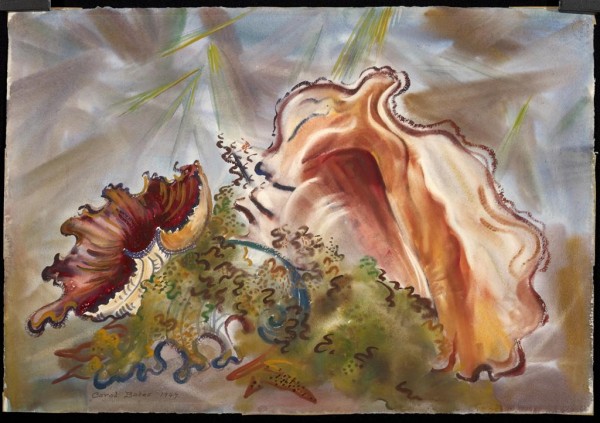
Carol Bates – American
Conch Shell
1947, Watercolor, 1959.1.2
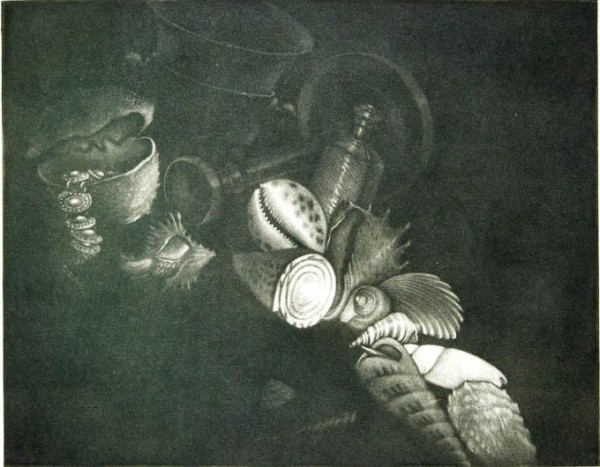
Tadensz Jackowski
Matka-natura II – Polish
1978, Etching, 1986.5.1
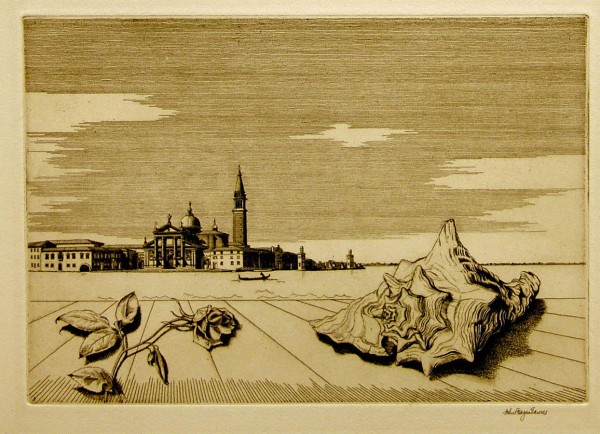
John Heagan Eames
Venetian Reverie
1960, Etching, 1992.1.39
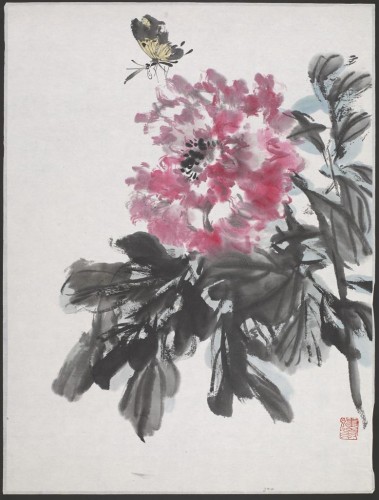
Chen Gin-ye
Pink Flowers with Butterfy
1998, Brush Painting, 1998.14.2
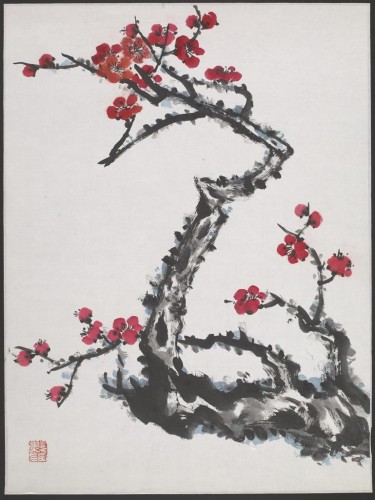
Chen Gin-ye
Branches with Red Blossoms
1998, Brush Painting, 1998.14.3
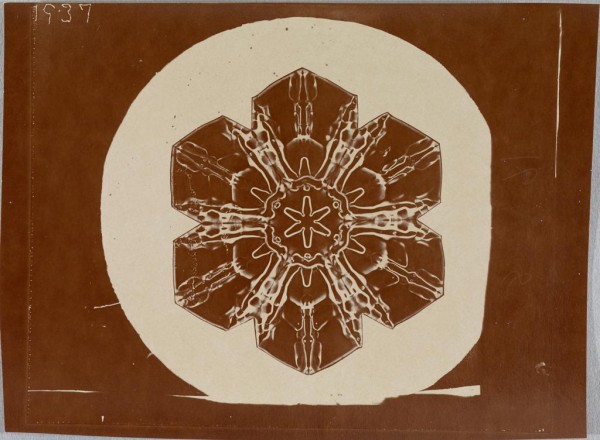
Wilson Bentley
Snow Crystals
c. 1920, Gelatin Silver Print, 2005.12.4
Teach It:
Materials:
- Tree branches (small to mid-sized, preferably with leaves still attached)
- Drawing paper
- Graph paper
- Pencils
- Protractors
- LCD projector
- Laptop
- Watercolor paper
- Water and water containers
- Newspaper
- Aprons
- Paper towels
- India ink
- Wash brushes
- Small round brushes
- Photographs of landscapes, animals and other natural forms
- Natural still life objects (pine cones, rocks, branches, flowers, sea shells, etc)
Procedure:
Time Allowed: Five forty-three minute classes.
Day 1:
The teacher will introduce the problem: how can mathematics measure the rough, jagged, broken, and wrinkled shapes found in the natural world? The teacher will compare finding the area of a circle with trying to measure a fern, mountain, or blood vessel.
The teacher will introduce Benoit Mandelbrot and his work trying to solve the problem of mapping and measuring organic forms, which resulted in the development of fractal geometry.
The teacher will introduce the concept of iterating an equation and how Mandelbrot iterated certain non-linear equations on a computer to create the Mandelbrot Set.
Students will iterate a simple non-linear equation such as y=x1 + 2. Students will plot the results five times on an XY axis.
The teacher will show examples of the Mandelbrot Set. The teacher will explain the fractal properties of iteration, scaling and self-similarity. The teacher and students will discuss the artistic properties of these computer graphics.
The teacher will direct a student volunteer to identify the two-dimensionality of a flat piece of paper. The student volunteer will crumple the piece of paper and students can consider the question: “Is the paper still two-dimensional?” The teacher will introduce the concept of fractal dimension: measuring the jaggedness of a surface. Can something have a dimension between 2-D and 3-D?
Students will explore the Cool Math Fractal Gallery.
The teacher will pass out drawing paper. Students will practice making a Koch Snow Flake, observing the fractal properties of the developing pattern.
Day 2:
Students will answer the bell activity question: “List five important facts about Benoit Mandelbrot.” Students will discuss their answers with the class and the teacher will generate a list on the board.
Students will form small groups and the teacher will pass out tree branches. Student volunteers will pass out protractors, drawing paper and graph paper.
The teacher will tell students that trees demonstrate fractal properties. The teacher will demonstrate measuring the angle of a branch.
Students will measure the different angles of the branches on their tree branch and record their results. Students will then discuss in their group how trees demonstrate scaling and self-similarity.
Student groups will report their findings to the class and the class will discuss the results.
Students will spend the remainder of the class sketching different views of their tree branch, closely observing detail and arranging the sketch on the paper in an aesthetically pleasing way.
Day 3:
Students will answer the bell activity question “What is a fractal?” Students will discuss their answers and try to agree on a definition.
The teacher will show examples of Chinese and Japanese brush painting from the Bates Art Museum archive.
Students will identify where they see fractal forms. Students will identify scaling, self-similarity and iteration in the different images.
The teacher will demonstrate different brush painting techniques: using thinned ink to create different values, using different kinds of repeated marks to create branches, leaves, mountains, water, animals, flowers, etc. The teacher will encourage students to create self-similarity and scaling with the different brush strokes.
Students will practice different brush strokes.
Students will brainstorm what they will create for their final painting. Students can create a variety of natural forms: mountains, flowing water, flowers, trees, animals, dragons, plants, rocks, clouds, etc. Students should think about how they could use fractal properties—scaling, iteration and self-similarity–in the painting.
Day 4:
Students will begin their final painting by blocking in different areas of their landscape with diluted ink. Students can work from their imagination, from looking at traditional brush painting, from natural still-life objects, from nature photography or from any combination of these sources.
Students will work into their painting with repeated brush strokes emphasizing fractal properties in their picture. Students should use different concentrations of ink to create different values in the image.
Students will pin their partially completed work to a bulletin board. As a class students will discuss where their classmates successfully used fractal forms in their artwork.
Day 5:
Students will work to complete their painting. Finished students can create another, smaller landscape.
Students will write a short paragraph describing their artwork and where they used fractal properties in their landscape.
Dig Deeper:
Assessment:
Working in groups, students can demonstrate that the angles in a tree branch are repeated between large and small branches by correctly measuring the angles with a protractor. Students can orally describe how tree branches demonstrate the fractal properties of self-similarity, scaling and iteration.
Bell Activities: Students can successfully answer the question “What is a fractal?’ and “List five important facts about Benoit Mandelbrot.”
Students can either write or describe orally where they included fractal forms in their landscape. Students can describe how their forms show self-similarity, scaling, and iteration.
Resources:
John Briggs, Fractals: The Pattern of Chaos: Discovering a New Aesthetic of Art, Science and Nature (New York: Simon Schuster, 1992).
Michael McGuire, An Eye for Fractals: A Graphic and Photographic Essay (Redwood City, CA: Addison Wesley Publishing Company, 1991).
Mayhall, Yolanda: The Sumi-E Book (New York: Watson Guptill Publications, 1989).
PBS Home Video, Nova: Fractals: Hunting the Hidden Dimension (WGBH Education Foundation, @2008).
Cool Math’s Fractal Gallery: http://www.coolmath4kids.com/fractals/index.html
After you have finished using this TWP lesson with your students, please help us improve the program by responding to this short survey at https://bates.co1.qualtrics.com/SE/?SID=SV_2oikOibUWoOemsl